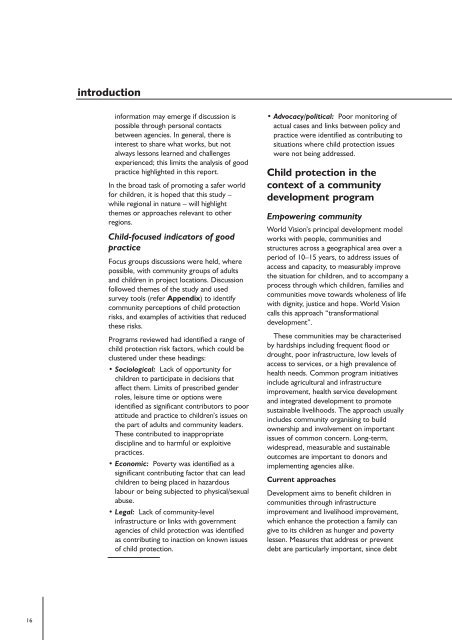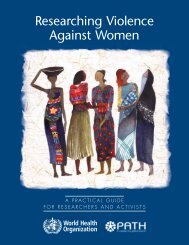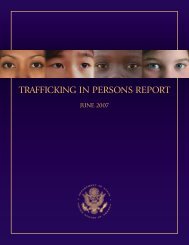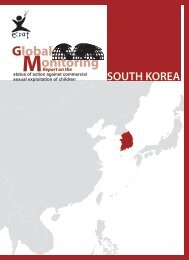Download PDF - Violence Against Children - East Asia and the ...
Download PDF - Violence Against Children - East Asia and the ...
Download PDF - Violence Against Children - East Asia and the ...
You also want an ePaper? Increase the reach of your titles
YUMPU automatically turns print PDFs into web optimized ePapers that Google loves.
introduction<br />
information may emerge if discussion is<br />
possible through personal contacts<br />
between agencies. In general, <strong>the</strong>re is<br />
interest to share what works, but not<br />
always lessons learned <strong>and</strong> challenges<br />
experienced; this limits <strong>the</strong> analysis of good<br />
practice highlighted in this report.<br />
In <strong>the</strong> broad task of promoting a safer world<br />
for children, it is hoped that this study –<br />
while regional in nature – will highlight<br />
<strong>the</strong>mes or approaches relevant to o<strong>the</strong>r<br />
regions.<br />
Child-focused indicators of good<br />
practice<br />
Focus groups discussions were held, where<br />
possible, with community groups of adults<br />
<strong>and</strong> children in project locations. Discussion<br />
followed <strong>the</strong>mes of <strong>the</strong> study <strong>and</strong> used<br />
survey tools (refer Appendix) to identify<br />
community perceptions of child protection<br />
risks, <strong>and</strong> examples of activities that reduced<br />
<strong>the</strong>se risks.<br />
Programs reviewed had identified a range of<br />
child protection risk factors, which could be<br />
clustered under <strong>the</strong>se headings:<br />
• Sociological: Lack of opportunity for<br />
children to participate in decisions that<br />
affect <strong>the</strong>m. Limits of prescribed gender<br />
roles, leisure time or options were<br />
identified as significant contributors to poor<br />
attitude <strong>and</strong> practice to children’s issues on<br />
<strong>the</strong> part of adults <strong>and</strong> community leaders.<br />
These contributed to inappropriate<br />
discipline <strong>and</strong> to harmful or exploitive<br />
practices.<br />
• Economic: Poverty was identified as a<br />
significant contributing factor that can lead<br />
children to being placed in hazardous<br />
labour or being subjected to physical/sexual<br />
abuse.<br />
• Legal: Lack of community-level<br />
infrastructure or links with government<br />
agencies of child protection was identified<br />
as contributing to inaction on known issues<br />
of child protection.<br />
• Advocacy/political: Poor monitoring of<br />
actual cases <strong>and</strong> links between policy <strong>and</strong><br />
practice were identified as contributing to<br />
situations where child protection issues<br />
were not being addressed.<br />
Child protection in <strong>the</strong><br />
context of a community<br />
development program<br />
Empowering community<br />
World Vision’s principal development model<br />
works with people, communities <strong>and</strong><br />
structures across a geographical area over a<br />
period of 10–15 years, to address issues of<br />
access <strong>and</strong> capacity, to measurably improve<br />
<strong>the</strong> situation for children, <strong>and</strong> to accompany a<br />
process through which children, families <strong>and</strong><br />
communities move towards wholeness of life<br />
with dignity, justice <strong>and</strong> hope. World Vision<br />
calls this approach “transformational<br />
development”.<br />
These communities may be characterised<br />
by hardships including frequent flood or<br />
drought, poor infrastructure, low levels of<br />
access to services, or a high prevalence of<br />
health needs. Common program initiatives<br />
include agricultural <strong>and</strong> infrastructure<br />
improvement, health service development<br />
<strong>and</strong> integrated development to promote<br />
sustainable livelihoods. The approach usually<br />
includes community organising to build<br />
ownership <strong>and</strong> involvement on important<br />
issues of common concern. Long-term,<br />
widespread, measurable <strong>and</strong> sustainable<br />
outcomes are important to donors <strong>and</strong><br />
implementing agencies alike.<br />
Current approaches<br />
Development aims to benefit children in<br />
communities through infrastructure<br />
improvement <strong>and</strong> livelihood improvement,<br />
which enhance <strong>the</strong> protection a family can<br />
give to its children as hunger <strong>and</strong> poverty<br />
lessen. Measures that address or prevent<br />
debt are particularly important, since debt<br />
16

















